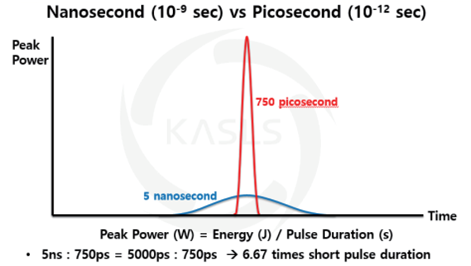
▶ Previous Artlcle : #18-2. Picosecond Laser
When the laser beam irradiation is shortened to be a nanosecond, the temperature within the tissue does not deviate from the target chromophore but be confined in the chromophore, and the surrounding normal tissues are not subjected to thermal damage, which is called ‘thermal confinement.’
In terms of thermal confinement, it is thermal relaxation time (TRT) that should be considered.
The TRT indicates the time that it takes for the heat of the target chromophore to rise and then fall by 50% after a laser is irradiated.
For instance, the TRT of a melanosome is 1μs.
[Advertisement] Reandnè Thread Series – Manufacturer: GTG WELLNESS(https://gtgwellness.co.kr/en/)
When a Q-switched Nd:YAG Laser with 5ns of a pulse duration is irradiated to a melanosome, the laser is irradiated for a shorter period than the TRT of the melanosome.
Thus, the heat in the melanosome generated by the laser irradiation is not transferred out of the melanosome.
This means that the laser can remove the target chromophore without thermal damage to the surrounding tissue, which is called subcellular selective photothermolysis.
Again, what is the difference between a picosecond and a nanosecond? A nanosecond is involved with thermal confinement through the TRT, while a picosecond is related to stress confinement through stress relaxation time (SRT).
When the laser is irradiated, heat is generated and the temperature in the tissue rises, causing expansion.
When the physical expansion occurs, it creates acoustic shock waves.
The time it takes for the acoustic shock wave from the center of a chromophore to reach its boundary is called SRT, and the SRT of the melanosome can be calculated by a formula (see Figure 4).

Figure 3. Nanosecond Laser(10-9 sec) vs. Picosecond Laser(10-12 sec).
-To be continued




















